
Click below to skip to individual topics:
Jump! ... 2 Jumping (Popping) Songs ... Turning Doorknobs ... Bedroom Privacy
Imitating Other Children ... Toileting ... Playmates ... Play Dates ... Drawing with Crayons
Reacting to Early Art ... Clay, Play-Doh & Play Dough ... How to Make Play Dough ... Fussy Eaters
Eating in the Car ... Listening to Sounds ... Listening Games ... My Vocabulary Grows to 300 Words
Holidays & Language Enrichment ... Sharing Your Life ... Playing Cards with Toddlers ... Talking About Process
Repeat After Me ... Children Need Clues ... Family Meals ... The 3 Major Hurdles: Eating ...
Sleeping, and Toilet Training ... A Big Toy Box vs ... a Toy Storage System
Don't Ask Questions Unless You Are Willing to Hear the Answer ... Picture Books for Twos
Lights, Camera, Action! ... Busy Work on a Rainy Day
Watching toddlers play with water and sand at the edge of a stream or at the beach is to understand how young children learn. They are like little professors, engaged in research. They don't need you to tell them about gravity; they will experience it as they pour sand from a shovel into a pail. Watching fathers at the water's edge is to understand their many roles, too.
Dad as research assistant.
As your child's research assistant, you hand your child tools that you know will work. You might suggest a variation of an activity. If you see the sand drying out, you might wet it with a little water. You don't direct the activity; you supplement it.
Dad as tour guide.
There are other roles you can play at the water's edge. First of all, your child didn't get there alone. You picked the spot and provided the transportation. You will watch out for the safety of your charge and get him or her home safely when the time is right. You have provided for food and snacks and, yes, like any good tour guide, you have thought about toileting considerations.
Dad as talk show host.
Did you ever notice how talk show hosts sit forward when they listen to their guests and how they maintain eye contact? They do this for a reason: It works. Both grown-ups and children respond when they feel their words are being listened to eagerly. Try it. Listen to your child talk about water and sand and mud as if he or she were the star of a talk show. You may want to do this for a while on site, and also later when you're home and reviewing the day.
Dad as media hound.
Well, why not? Indulge yourself. Take photos. Take videos. Write a journal. It's fun, and your productions will be enjoyed for years and years.
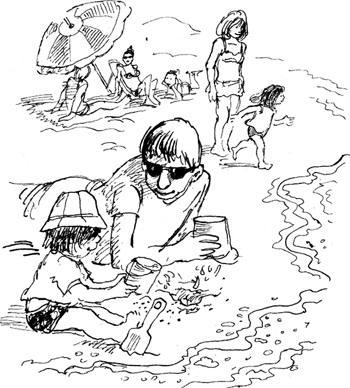
Jump!
Around this age many children begin to learn to jump. They experiment by lifting both feet off the ground and jumping in place. This is an exciting accomplishment for them and one you might miss if you weren't alerted to it. When toddlers first discover that they can (more or less) jump, they are quite amusing to watch. This is a good time to get out the video camera. You might want to record other current physical accomplishments, too: walking forward, walking backward, and running.
2 Jumping (Popping) Songs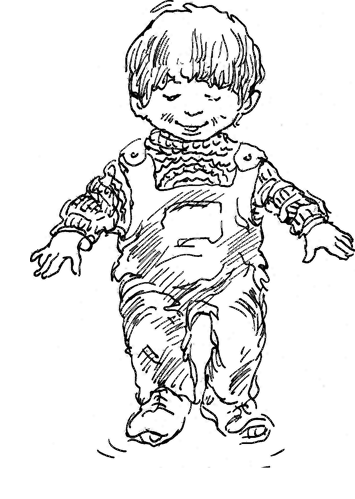
"Pop Goes the Weasel."
All around the cobbler's bench; the monkey chased the weasel.
The monkey thought 'twas all in fun; POP! (jump) goes the weasel.
A penny for a spool of thread; a penny for a needle.
That's the way the money goes; POP! (jump) goes the weasel.
"Popcorn Song."
(sung to the tune of "I'm a Little Teapot'')
I'm a little popcorn in a pot.
Heat me up and watch me pop.
When I get all fat and white, I'm done.
Popping corn is lots of fun.
POP! (jump)
POP! POP! POP!
(keep kumping)
Children like to act out songs in physical ways. These two songs offer practice in jumping. Toddlers like to anticipate the moment in the song when they are supposed to jump.
Turning Doorknobs
Toddlers get better and better at eye-hand coordination. Their manual dexterity improves to the point where they can unscrew little jar lids that aren't fastened too tightly and turn doorknobs. This is the time to make extra sure that any jars you don't want your child to open are put safely out of reach and any doors you don't want your child to open are locked.
Bedroom Privacy
There may be certain times when you'd rather not have your child enter your bedroom. For that reason, now is the time to install a latch on your side of the door. A latch gives you a little time to get ready for ...
... a visiting toddler.
Imitating Other Children
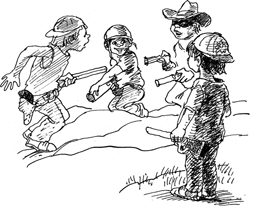 Toddlers are watchers and doers. They frequently try to copy what they see because imitation is one of the main ways they learn. Unfortunately, you can't always control what they see. Toddlers are watchers and doers. They frequently try to copy what they see because imitation is one of the main ways they learn. Unfortunately, you can't always control what they see.
Sooner or later, your child will see and try to imitate activities that you may not approve of. Older children acting out pretend violence provide some of the most vivid scenes a toddler can watch. If you feel strongly, for example, that fantasy gun play is too "old" for your child to witness, you can take your child to the toddler section of the park instead and generally avoid places where older children play. As your child grows, you will have plenty of opportunity to talk with your child about what he or she sees in the world about you. You will have time to discuss the meanings of things and what your feelings are about right and wrong.
Toileting
Watching how older children take care of themselves can help toddlers learn what they need to learn in order to grow. Give your child a chance to copy the positive behaviors of older children. Sometimes a sympathetic older sibling can help immeasurably in the toilet training of a toddler. At this age many toddlers are able to let you know when they need to go to the toilet.
Playmates
We all want our children to be liked by others and to have friends. One of the most intriguing aspects of being a parent is watching your child in relationships with peers. Some children make friends easily; others are shy and take more time. Some children only want to play with familiar children; others will play with anyone. Some children like to be with other children most of the time; others are content to play alone. To find out how your child is with others, carefully observe him or her. When you do this, try to stay in the background and try to be nonjudgmental. See your child as a separate person, not a clone of yourself. Just because you were gregarious in your youth doesn't mean your child will be the same way.
If you see that your child seems to want to play with others but has trouble doing so, you can help in subtle ways. One thing you can do is start playing with something you know your child likes. Children this age, for example, like to pour water from little plastic teapots into little plastic cups. If another child wants to join in the fun, you can let that child take your place, thereby uniting the two children in play. Stay close by as long as your child needs you there.
Play Dates
If you want your child to be invited to play at other children's homes, you have to be prepared to invite one or two other children to your home. It takes a little practice to supervise a play date successfully. Here's some advice to help you get started.
• Safety comes first.
Whatever you do with the children, be sure that it's safe. Keep your eye on the children at all times.
• Set out a variety of toys that toddlers like.
Children this age often play together in the same space but with separate toys. When they tire of a toy, they move on to something else. Be prepared to suggest alternative toys to children who want what another child is already using.
• Have simple snacks available that are easy to serve.
Raisins, hard crackers, bananas, and. apple juice in cups are good. Ask parents to bring bottles if their children still use them.
• Keep play dates short.
One or two hours is enough at first.
Drawing with Crayons
At this age many children will scribble and draw circles with a crayon. A fat crayon is still best. If you draw a line on a piece of paper and ask your child to draw one like it, chances are your child will be able to comply. If your child likes this kind of copying activity, you can make a cross and other very simple designs to copy. This is more of a prewriting kind of activity than it is an artistic activity. To encourage artistic freedom, just let your child draw however he or she wants. All you need to provide are crayons of different colors and lots of paper.
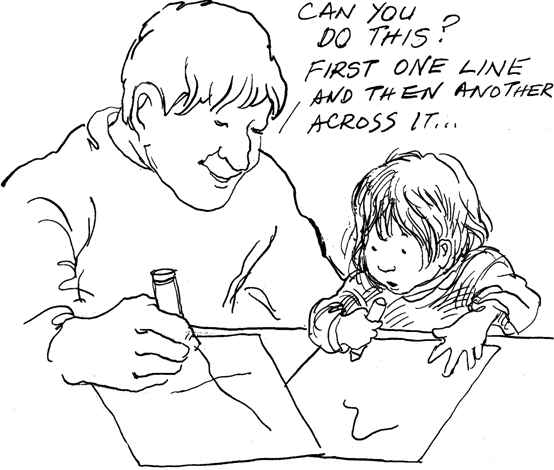
Reacting to Early Art
You can, of course, rave about your child's early artistic creations, but another way to respond is to show your respect by commenting on the pictures. "Hmm-m," you might say. "Look at that blue line. What a fine blue line it is. And here's an orange line, and look, there's a little red squiggle." By talking about your child's art work, you demonstrate your interest and supply descriptive language, as well.
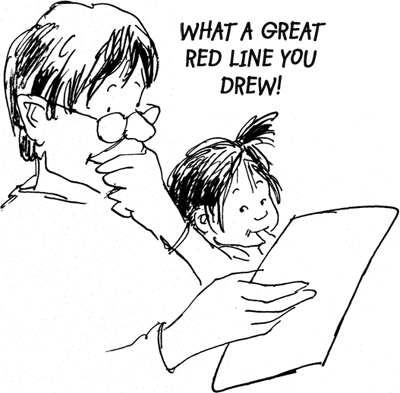
Clay, Play-Doh & Play Dough
Real clay.
Not only is most potter's clay too hard and messy for toddlers to play with, but it also dries out. If you want to buy real clay, make sure it is nonhardening.
Play-Doh.
Play-Doh is a modeling material that is less messy than clay. It comes in bright colors and smells weird. Kids like Play-Doh. Competitive products may be labeled just Dough. Store Dough and Play-Doh in the containers they come in, and make putting all the bits and pieces of Play-Doh back into the containers the last part of any Play-Doh activity.
Play dough.
You can make play dough yourself (see below). It's cheap and works just fine.
Clay, Play-Doh, and play dough are great art materials for toddlers. Kids can push, pull, smash, and form objects with them readily. They like to make snakes, worms, hot dogs, hamburgers, pancakes, peas, faces, balls, snowmen, and monsters. Provide toothpicks to stick in the monsters, but supervise the use of toothpicks carefully.
How to Make Play Dough
Many fathers think they would never make play dough. But when you're stuck with a few toddlers on a rainy day and you can't think of anything interesting to do, making play dough can be fun. All that is required are inexpensive household ingredients that you probably already have on hand. Teach toddlers not to eat play dough.
Play dough recipe:
Mix 1/2 cup water with 1 tablespoon salad oil. Stir in 2 cups flour and 3/4 cup salt. Work with your hands until the mixture is smooth and thick as bread dough. If necessary, add more water. Have children wash their hands before they mix and play with the dough. Store dough in the refrigerator. If children have colds, through the dough out.
Fussy Eaters
Everybody is looking at you. They are begging you to eat. But you don't eat. You are more powerful than all of them put together. You can get them all to pay attention to you - and only you! Children are not stupid. One of the ways they can push your buttons is by not eating. Before you let this happen, consider the possibilities: your child may not be hungry or may not like the food. In the latter case, you may want to offer a few alternatives, but don't go overboard. As for the first case, forget it. Let your child get down from the high chair and don't play into his or her power trip.
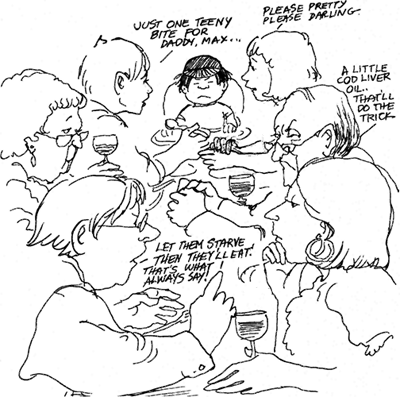
Eating in the Car
Before you leave on trips, prepare a bag of snacks to assuage hunger attacks in the car. Choose snacks, like those suggested below, that your toddler can eat in his or her car seat without making too much of a mess.
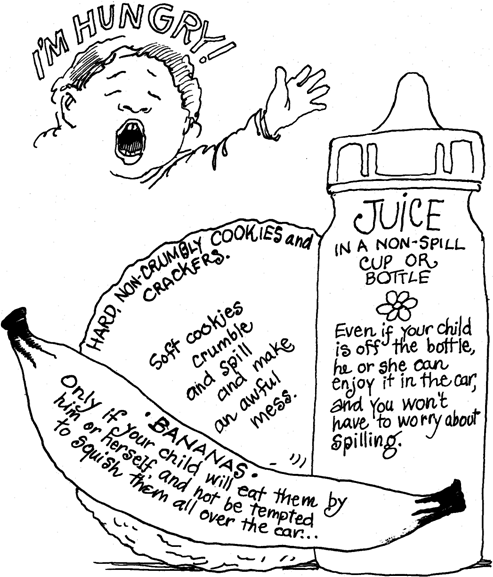
Listening to Sounds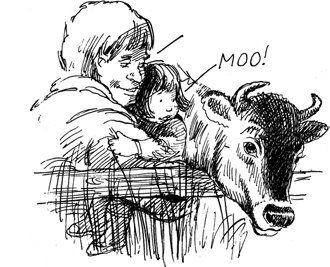
When you're out and about in the world with your toddler, discuss not only the wonderful things you see together, but also the wonderful noises and sounds you hear. Toddlers like to hear you imitate the sounds of trains, cars, airplanes, trucks, horns, church bells, and, most of all, animals. Children love to learn the sounds of different animals - primarily through real-life experience but also through pictures in books. With books, you have to provide the sound for each animal. Soon you'll be able to ask your child, "What does the cow say?"
Listening Games
Invent listening games for your child. The basic idea behind each game is for your child to identify an object out of sight by its sound.
Close your eyes:
Have your child put his or her hands over his or her eyes. Then have someone in the family say something like "teddy bear." Ask your child, "Who said that?"
Hidden objects:
Put a sound maker in a bag or behind your back. Ask your child, "What do you hear that I'm hiding behind my back?" Good items to hide: an alarm clock, a rattle, a stuffed animal that squeaks, a little bell, a tambourine. For the game to work, your child has to know about these things ahead of time.
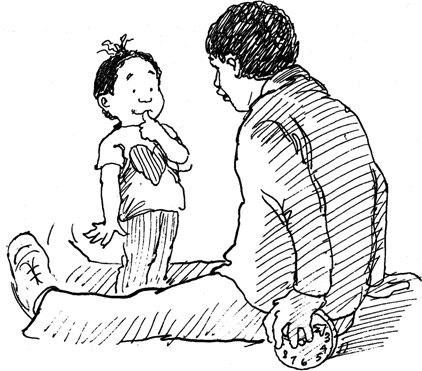
My Vocabulary Grows to 300 Words
Watch for the emergence of more sophisticated understandings and word usages.
New words:
Most of the words your toddler learns are the names of familiar objects: sock, shoe, fork, button, hat. Your child may understand but not be able to say all these new words.
Prepositions:
If you say, "The ball is under the couch," does your child understand what the word under means? Play games to help your child comprehend words that tell where things are. Hide a ball in different, easy places and use various prepositions, such as on top of and behind, to help your child find it.
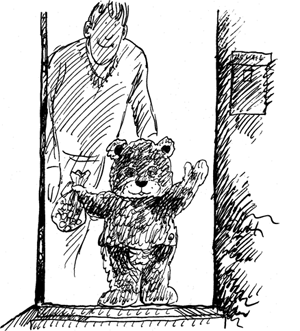 Holidays & Language Enrichment Holidays & Language Enrichment
Holidays provide exciting changes in daily routines. Children enjoy them most when the new and different events are not overstimulating and when holiday preparations are simple enough for children to share and enjoy. The simpler things are, the richer they are for children because there's time for them to absorb and learn words that go with the new experiences.
PS: While the toddler above is in full costume, many toddlers do not like allencompassing costumes and face masks. So, when you think costumes, it's best to start simple and see how your child feels, literally.
Sharing Your Life
Sharing means sharing, not imposing. It won't work to impose your favorite activity on your toddler. But if you have patience and understand your child's needs, you may be able to enjoy your favorite pastimes together. For example, if you want to watch a game on TV while taking care of your child, make sure your child has safe, interesting toys close by as well as food for snacks. When your child needs attention, be prepared to supply it. Cuddle your child on your lap, and teach your child how to cheer. But don't expect your child to understand the game, and be prepared ahead of time for inevitable interruptions. During critical moments, your child will need a diaper change. That's life. That's fatherhood. That's the ball game. Don't fight it. If you can't be flexible, don't watch your kid and a ball game at the same time.
P.S. If your team loses, don't go ballistic. See yourself through your child's wondrous eyes. Do you like what you see?
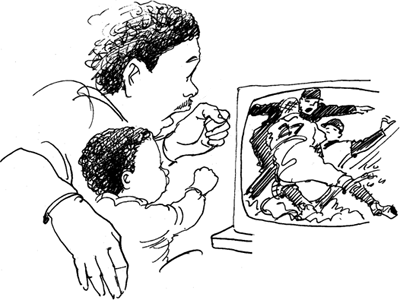
Playing Cards with Toddlers
You many have in mind a card game, such as slapjack to teach your child. But in fact your toddler is probably too young for that game. Your child likes to put cards in cardboard boxes and take them out again. Your child likes to pretend he or she knows what numbers are on cards. Observe what your child likes to do with cards, and see if you can play that game, too.
3 toddler card games:
Post Office
You prepare the "post office" by cutting a slot in a cardboard box.
You and your child then "mail" the cards by putting them in the slot.
Red Cars and Black Cards
Match them.
That's all.
Numbers
Pick up a card and say its number.
Your child can't do this but likes to anyway!
Talking About Process
When in doubt about what to discuss with your child, talk about what you are doing. Talking about the process of things gives children a sense of sequence and the connection between the steps of a process. Sometimes talking out loud about what you're going to do helps you organize yourself, too.
Repeat After Me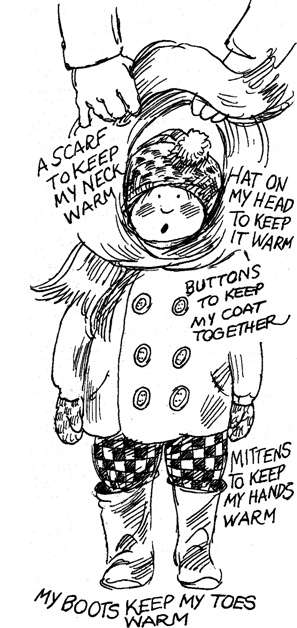
Use repetitive chants to help your child develop descriptive language skills and (and this is important) to become more cooperative. In this chant, you say something from your child's point of view and then your child repeats it.
You: A scarf to keep my neck warm.
Child: A scarf to keep my neck warm.
You: A hat to keep my head warm.
Child: A hat to keep my head warm.
You: Buttons to keep my coat together.
Child: Buttons to keep my coat together.
You: Mittens to keep my hands warm.
Child: Mittens to keep my hands warm.
You: Boots to keep my toes warm.
Child: Boots to keep my toes warm.
Adapt the chant for getting undressed, such as:
You: Off comes the scarf that kept me warm.
Child: Off comes the scarf that kept me warm.
Your child will not speak as clearly or as well as you do, but don't be critical. Accept your child's language as is. Chanting should be fun!
Looking at Things Up Close
Toddlers see the world up close, and they like to touch it. When you take a toddler to the park or out in the backyard, be prepared to sit down and look at individual things, such as acorns, leaves, stones, sticks, and seashells. Also be on the alert to be sure that your toddler doesn't try to eat these things.
Don't hurry. If you feel impatient, disappointed that instead of having a nice, brisk outdoor walk, here you are sitting, take a deep breath and relax. This time outdoors is for your toddler, who needs to stop and study things.
Talking About Nature
The more you talk to your child about nature, the more your child will learn about it - and the more complex this learning will be.
The names of things:
By hearing you name things casually, your child will learn that different
things in nature have different names and will eventually be able to say these names.
The variety of things:
By hearing you talk about the colors and shapes of things,
your child will begin to learn descriptive words and to appreciate variety in nature.
The organization of things:
By watching you sort objects, for example, putting shells with shells
and stones with stones, your child will begin to learn to sort and classify objects.
The connection between things:
By listening to you talk about seeds and plants, your child will begin
to learn about the life cycle. Of course, this learning will be only on a toddler level,
but that level forms the basis for more learning to come.
Grow plants together:
Let your toddler use a toy rake to imitate you at work in the garden.
If you don't have a garden, grow some plants on the windowsill,
and let your child help you water them, using a little pitcher.
From garden to the table:
Every now and then, pick peas, strawberries, corn, or other food plants,
and prepare them for supper. Show the connection between the earth and what we eat.
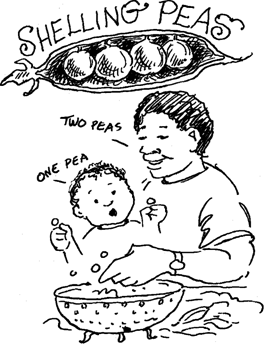
Children Need Clues
Children need to know what's happening because they want to make sense of the world. They can't see patterns where there are none. They need to keep basically the same schedule every day, and they need your behavior to be fairly predictable. They like you to tell them what's going to happen next, and they like to be able to trust your words. Changes, of course, are inevitable. Holidays change life. Baby-sitters come and go. People move. Parents take trips. Such changes cannot be helped, but what helps children cope with these changes is the constancy of what they usually experience.
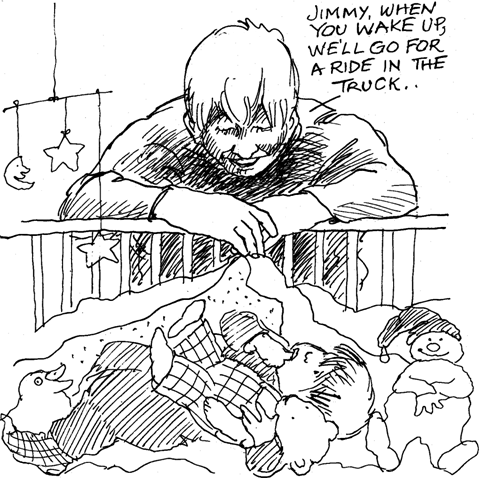
Family Meals
Modern families often have trouble establishing daily routines. Fathers and mothers may work late. Parents' jobs may be at different times, and jobs may change. Relatives living with the family may come and go. With all the hustle and bustle of daily existence, families may not get a chance to sit down with one another and share even one meal a week. If your family has this problem, try to figure out a solution because children need consistent family rituals and routines. Think of family meals as a gift that you need to give your child at least three or four times every week.

The 3 Major Hurdles: Eating ...
In an ideal world, parents would soar with their toddlers over all hurdles. The toddlers would eat everything put before them, sleep through the night, and become toilet trained within a week. However, it's not an ideal world; and most parents and toddlers soar over only two of the three hurdles; some soar over only one. The one or two major hurdles left are stumbled over.
... Sleeping and Toilet Training
Fortunately, however, by the time toddlers metaphorphosize into high school graduates, no one remembers or cares which hurdles they soared over and which hurdles they missed. If, currently, you are stressed out by one, two, or three of the three normal problems, be reassured. Eventually your child will eat vegetables, sleep well, and go to the toilet at night without waking you up.
A Big Toy Box vs ...
A big toy box seems like a good idea, and sometimes carpenter fathers enjoy making one. But think about it: small children can't weed around in a big toy box. To find a certain toy, they have to take everything out, so instead of eliminating confusion, big toy boxes actually add to it. Better to put your energies toward a storage system rather than one big box.
A toy storage system enables you at the end of a hectic afternoon to sort toys and store them away for future use. That way, at the next play time, you can bring out only a few toys and sets of toys. When your child's interest in the toys diminishes, you can put away those toys and bring out new ones. Newly introduced sets of toys are more interesting to children than a mixture of toys scattered across the floor of a room.
When storing toys, keep similar toys together: little cars in a shoe box, dolls and doll clothes in another box, snap-lock beads in a tin can, lacing beads in another can, and so on.
Classification and cooperation.
Sorting toys is also an educational experience for children, and if you can put the right spin on it, a cooperative sort of game to play together.
... a Toy Storage System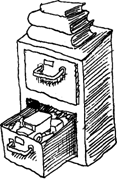
In thinking through a storage system, consider fitting a closet with shelves for toys and games. If you don't want your child to be able to get into the closet, put a latch high up on the door. But there's no reason why your child shouldn't be able to get into the closet if you store lightweight and safe toys on the shelves he or she can reach. 
A bottom drawer
You can also store toys in a special bottom drawer of a desk or bureau. When you want to provide your child with the toys, pull out the entire drawer and set it on the floor.
Cardboard file cabinets.
A cardboard file cabinet is cheap, lightweight, safe, and can be taken on a trip.
Don't Ask Questions Unless You are Willing to Hear the Answer
Never ask your child a question unless you are prepared to hear your child's answer. For example, don't ask your child if she wants to kiss Grandma unless you are absolutely sure she or he will say yes. Keep this concept in mind throughout your years of child-rearing. For example, "Do you want to go to school?" is a risky question. A better question is, "What are you going to wear to school today?" And that only works if you don't impose a strict dress code.
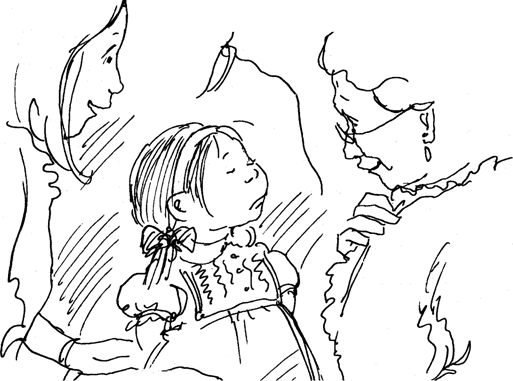
Picture Books for Twos
Two-year-olds can handle books that are more complicated than baby books, but they still can't comprehend picture books with confusing, abstract pictures and overly complex stories. Select books for your child that have clear, recognizable pictures and a simple, memorable text.
Art books and coffee table books may have big colorful pictures that your child might like to look at with you. But be aware that your child may want to touch the pictures and will see the pictures from a different point of view.
Lights, Camera, Action!
On sunny days when you have lots of energy and feel like planning a project with other parent friends and a bunch of toddlers, consider making a movie.
Such projects can provide a focus to family gatherings. In future years at gatherings of the same people, you'll enjoy viewing the movie you made together. You need other gung-ho adults to help you, and, of course, you need a video camera. The plot of the movie can be as simple as "Let's Make a Parade." Take footage of each child getting ready for the parade (costumes, makeup, rehearsal) and then of the parade itself.

Busy Work on a Rainy Day
Paint with Water books are wonderful, mindless, not creative, not intellectually stimulating but nevertheless captivating books for children. If they were the only art supplies you provided for your child, you would be amiss. But, assuming that is not the case, these books can keep a fussy child happy for a while. All you do is sit your child down in a comfortable place and provide a brush and water in a cup, preferably a bottom-weighted child's cup that doesn't easily tip. Your child paints the water onto the pictures, and presto, colors appear. Usually you can find these books in drugstore racks that also sell coloring books. Keep a supply handy for those times when you need to keep your child pleasantly occupied and can't think how to accomplish that.
CLICK FOR CHAPTER FIVE |

